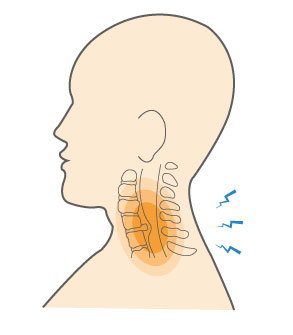CERVICAL DISC HERNIATION
CERVICAL DISK HERNIATION
Cervical disc herniation is a condition where one of the discs in the cervical spine (neck) becomes damaged and the soft inner material (nucleus pulposus) pushes out through a crack in the outer layer (annulus fibrosus). This can put pressure on the surrounding nerves and cause pain, numbness, and weakness in the arms and hands.
The causes of cervical disc herniation may include:
- Age-related degeneration: The discs in the cervical spine may degenerate over time, becoming less flexible and more prone to herniation.
- Trauma: Injury or trauma to the neck may cause a disc to herniate.
- Poor posture: Prolonged poor posture, such as hunching over a computer, can put excessive stress on the neck and increase the risk of disc herniation.
- Repetitive motions: Repetitive motions that involve the neck, such as heavy lifting or sports that require repetitive head movements, can increase the risk of disc herniation.
- Genetics: Some people may be more prone to disc herniation due to genetic factors.
Symptoms of cervical disc herniation may include neck pain, pain or numbness that radiates down the arm, muscle weakness in the affected arm, and changes in reflexes.
Treatment options for cervical disc herniation may include physiotherapy, pain management techniques, medications, and in some cases, surgery. A healthcare professional can provide a proper diagnosis and recommend the most appropriate treatment plan for each individual case.
SYMPTOMS OF CERVICAL DISK HERNIATON
The symptoms of cervical disc herniation can vary depending on the location and severity of the herniation. Some common symptoms may include:
- Neck pain: A dull or sharp pain in the neck that may worsen with movement.
- Arm pain: Pain that radiates from the neck down into the arm or hand, often following a specific nerve pathway.
- Numbness or tingling: A sensation of numbness or tingling in the arm, hand, or fingers.
- Weakness: Weakness in the muscles of the arm, hand, or fingers may occur due to pressure on the nerves.
- Loss of sensation: A loss of sensation or a decrease in sensation in the arm, hand, or fingers.
- Limited range of motion: Difficulty moving the neck or turning the head.
- Headaches: Pain in the back of the head or the base of the skull may occur.
In some cases, cervical disc herniation may also cause muscle spasms, difficulty with balance, or bladder or bowel dysfunction. It is important to seek medical attention if you experience any of these symptoms, as cervical disc herniation can be a serious condition that requires proper diagnosis and treatment.
ROLE OF PHYSIOTHERAPY IN CERVICAL DISK HERNIATION
Physiotherapy can play an important role in the management of cervical disc herniation. The goals of physiotherapy for cervical disc herniation are to alleviate pain, improve mobility, restore function, and prevent further injury.
The physiotherapist will conduct a thorough assessment to determine the extent of the injury and develop an individualized treatment plan that may include:
- Pain management: The physiotherapist may use various Electro modalities such as heat or ice therapy, electrical stimulation, or ultrasound to help reduce pain and inflammation.
- Exercise: Specific exercises may be prescribed to improve range of motion, strength, and flexibility of the neck and upper extremities. Strengthening exercises for the neck and upper back muscles may also help to improve posture and reduce strain on the cervical spine.
- Manual therapy: Hands-on techniques such as mobilization or manipulation may be used to help restore normal joint movement and reduce muscle tension.
- Education: The physiotherapist may provide education on proper posture, body mechanics, and ergonomics to help prevent future injury.
- Home exercise program: The physiotherapist may prescribe specific exercises to be done at home to continue the progress made during therapy sessions.
- Prevention: The physiotherapist may also provide guidance on how to prevent future episodes of cervical disc herniation by avoiding activities that place excessive stress on the cervical spine, maintaining good posture, and exercising regularly.
